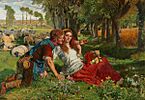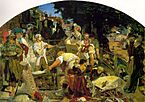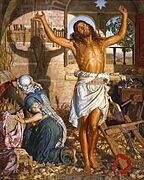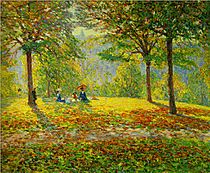Manchester Art Gallery facts for kids
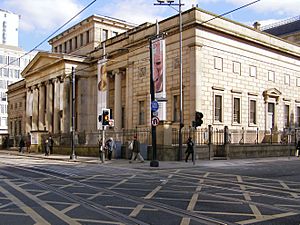 |
|
| Established | 1823 |
|---|---|
| Location | Mosley Street, Manchester, England |
| Collections | approx. 25,000 objects |
| Collection size | 807,000 sq ft (75,000 m2) in 94 galleries |
| Visitors | 514,852 (1 April 2013 – 31 March 2014) |
| Public transit access | Metrolink: St Peter's Square and Piccadilly Gardens stations |
|
Listed Building – Grade I
|
|
| Official name: Manchester Art Gallery | |
| Designated: | 25 February 1952 |
| Reference #: | 1282980 |
The Manchester Art Gallery is a famous art museum in Manchester city centre, England. It is located on Mosley Street. The gallery is free to enter and is open six days a week, closed on Mondays.
The main building was first built in 1823 for a special group called the Royal Manchester Institution. Today, the gallery uses three buildings that are connected. Two of these buildings were designed by a famous architect named Sir Charles Barry. The building that links them was designed by Hopkins Architects. The gallery had a big update and expansion project and reopened in 2002.
Manchester Art Gallery has a huge collection of more than 25,000 art pieces. These include many important works from both local and international artists. Over half a million people visited the museum in one year, according to figures from 2014.
Contents
History of the Gallery
How the Gallery Started
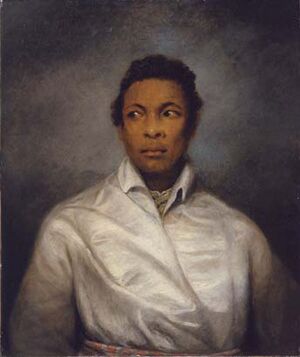
The gallery began with a group called the Royal Manchester Institution. This group was formed in 1823. Their first home was in what is now the main gallery building on Mosley Street.
In 1827, they bought their very first artwork. It was a painting called A Moor by James Northcote. This painting shows the famous Black actor Ira Aldridge.
The Royal Manchester Institution opened its doors to the public in 1833. They held art shows and collected many beautiful artworks. In 1882, the group gave their buildings and art collection to the Manchester Corporation. This is how it became the Manchester Art Gallery we know today.
The agreement was that £2,000 would be spent on new art every year for 20 years. The gallery bought many artworks. By the end of the 1800s, they had a very impressive collection. Many wealthy people from Manchester also gave art as gifts.
A Protest for Women's Rights
On April 3, 1913, three women protested at the gallery. They were fighting for women's suffrage in the United Kingdom, which meant they wanted women to have the right to vote. During their protest, they broke the glass of 13 paintings. This included artworks by famous artists like John Everett Millais and George Frederick Watts. Four of the paintings were damaged by the broken glass.
How the Gallery is Run
The Manchester Art Gallery is managed by Manchester City Galleries. This is a part of the Manchester City Council. They also look after other places like Platt Hall.
Since 2018, Alistair Hudson has been the director of the galleries. He also directs the University of Manchester's Whitworth Art Gallery. This is part of a special partnership between the council and the university.
The city council helps pay for the gallery. However, the Manchester Art Gallery Trust also provides money. This trust is a charity that helps support the gallery's work. They raise almost half of the money needed from companies, people, and other groups.
The gallery is open every day except Mondays. On the first Wednesday of each month, it stays open until 9 PM.
Buildings of the Gallery
Manchester Art Gallery is made up of three buildings that are connected. The main building, which faces Mosley Street, was built between 1824 and 1835. It was originally home to the Royal Manchester Institution.
This building was designed by Sir Charles Barry. It is built in the Greek Ionic style, which means it looks like ancient Greek temples. It has two floors and a grand entrance with six tall columns. This building is now a very important historic site, known as a Grade I listed building.
The Manchester Athenaeum is another building that is part of the gallery. It was also designed by Sir Charles Barry and built in 1837. The city bought it in 1938 to make more space for the art gallery. The Athenaeum is designed in the Italian Palazzo style, which looks like grand Italian palaces. It faces Princess Street.
In 1994, a competition was held to find a design to update the old gallery and the Athenaeum. The goal was to connect them with a new building. Many architects entered, and Michael Hopkins and Partners won in 1995. The gallery closed in 1998 for the work to be done. It reopened in 2002 after a big renovation and expansion project.
Art Collections
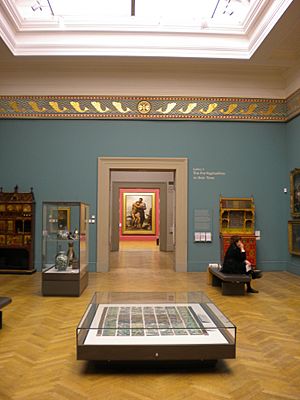
The gallery has an amazing collection of fine art. This includes over 2,000 oil paintings, 3,000 watercolours and drawings, and 250 sculptures. There are also about 1,000 prints.
The museum also has more than 13,000 decorative art objects. These include things like ceramics, glass, furniture, and even doll houses. The oldest item in the collection is an Egyptian canopic jar from around 1100 BC.
Manchester Art Gallery is especially known for its collection of Victorian art. This includes many works by the Pre-Raphaelite Brotherhood, a group of artists from the Victorian era. It also has many beautiful Victorian decorative arts.
The gallery displays several paintings by the French artist Pierre Adolphe Valette. He painted and taught in Manchester in the early 1900s. You can see his paintings of foggy Manchester streets and canals. A painting by Paul Cézanne hangs nearby, showing how similar his misty French river bridge is to Valette's Manchester scenes.
L. S. Lowry was one of Valette's students. You can see how Valette's style influenced Lowry by looking at their paintings side-by-side in the gallery. While many of Lowry's works are at The Lowry gallery in Salford, Manchester Art Gallery has his 1954 painting Piccadilly Gardens.
The museum also has The Picnic (1908) by Wynford Dewhurst, who was born in Manchester. Other artists from Manchester, like Annie Swynnerton and Susan Dacre, also have many paintings in the collection.
Besides paintings, the museum has collections of glass, silverware, and furniture. This includes four pieces by the Victorian architect and designer William Burges.
In January 2018, the gallery temporarily removed a painting called Hylas and the Nymphs (1896) by John William Waterhouse. They left the space empty to start a discussion about how women's bodies are shown in art. Visitors could leave notes with their thoughts. The gallery was surprised by how many people reacted strongly to this. After a week, the painting was put back.
Highlights of the Collection
-
The Sirens and Ulysses by William Etty, 1837.jpg
William Etty
The Sirens and Ulysses
1837 -
William Holman Hunt
The Hireling Shepherd
1851 -
William Holman Hunt
The Scapegoat
1854–1855 -
Ford Madox Brown
Work
1865 -
Waterhouse Hylas and the Nymphs Manchester Art Gallery 1896.15.jpg
John William Waterhouse
Hylas and the Nymphs
1896
Famous Artists in the Collection
The gallery has works by many important artists from different art schools:
- Dutch School: Artists like Aelbert Cuyp, Meyndert Hobbema, Pieter de Hooch, and Jan Steen.
- English School: Famous names include John Constable, Thomas Gainsborough, William Hogarth, L. S. Lowry, Joshua Reynolds, and Joseph Mallord William Turner.
- Flemish School: Includes works by Frans Francken the Younger and David Teniers the Younger.
- French School: Features artists such as Jean-Baptiste-Camille Corot, Edgar Degas, Paul Gauguin, Claude Lorrain, and Pierre-Auguste Renoir.
- Italian School: Has paintings by Bernardo Daddi, Luca Giordano, and Guido Reni.
Temporary Exhibitions
The gallery often hosts special temporary exhibitions. For example, in 2013, they featured an exhibition by the artist Raqib Shaw.
See also
 In Spanish: Galería de Arte de Mánchester para niños
In Spanish: Galería de Arte de Mánchester para niños



